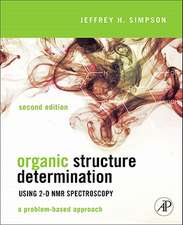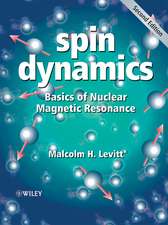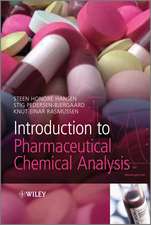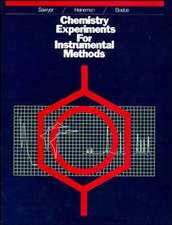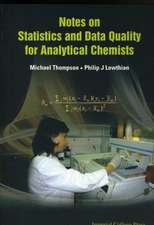Pulse and Fourier Transform NMR: Introduction to Theory and Methods
Autor Thomas C. Farrar, Edwin D. Beckeren Limba Engleză Hardback – 23 sep 1971
Preț: 430.51 lei
Preț vechi: 559.10 lei
-23% Nou
Puncte Express: 646
Preț estimativ în valută:
82.38€ • 86.24$ • 68.16£
82.38€ • 86.24$ • 68.16£
Carte tipărită la comandă
Livrare economică 07-21 aprilie
Preluare comenzi: 021 569.72.76
Specificații
ISBN-13: 9780122496509
ISBN-10: 0122496507
Pagini: 118
Ilustrații: 1
Dimensiuni: 152 x 229 x 14 mm
Greutate: 0.37 kg
Ediția:00006
Editura: ELSEVIER SCIENCE
ISBN-10: 0122496507
Pagini: 118
Ilustrații: 1
Dimensiuni: 152 x 229 x 14 mm
Greutate: 0.37 kg
Ediția:00006
Editura: ELSEVIER SCIENCE
Cuprins
PrefaceAcknowledgmentsSymbols and Abbreviations1. Basic Concepts in NMR 1.1. Relaxation and Nuclear Magnetic Energy Levels 1.2. Some Basic Properties of Vectors 1.3. Nuclear Precession 1.4. The Bloch Equations 1.5. The Rotating Frame of Reference 1.6. Magnetization in the Rotating Frame 1.7. Fourier Analysis and Fourier Transformation2. Free Induction and Spin Echoes 2.1. Free Induction Decay 2.2. Measurement of T1 2.3. Measurement of T2 by the Spin-Echo Method 2.4. The Carr-Purcell Technique 2.5. The Meiboom-Gill Method 2.6. Fourier Transform Methods 2.7. Weak Pulses and Selective Relaxation Measurements 2.8. Summary of Basic Pulse Methods3. Instrumentation 3.1. The Pulsed NMR Spectrometer 3.2. The NMR Sample Probe 3.3. The rf Gate, Pulse Programmer, and rf Transmitter 3.4. The Amplification and Detection System 3.5. Systematic Errors in Pulsed NMR Instruments4. Relaxation Mechanisms 4.1. Frequency Distribution of Molecular Motions 4.2. Spin-Lattice Interactions 4.3. Dipole-Dipole Relaxation 4.4. Quadrupole Relaxation 4.5. Relaxation via Chemical Shift Anisotropy 4.6. Scalar Relaxation 4.7. Spin-Rotation Relaxation 4.8. Summary of Relaxation Mechanisms5. Fourier Transform NMR 5.1. Use of the FT Method in Multispin Systems 5.2. Instrumental Requirements 5.3. Computer Requirements 5.4. Effect of Τ1 on Signal/Noise Improvement 5.5. Multiple-Pulse Techniques 5.6. Transient Species; Measurement of Relaxation Times 5.7. Stochastic Excitation6. Rotating Frame Experiments 6.1. Transient Nutations 6.2. Rotary Spin Echoes 6.3. Forced Transitory Precession; "Spin Locking" 6.4. Waugh Pulse Sequences7. Selected Applications 7.1. Molecular Diffusion 7.2. Chemical Rate Processes 7.3. Molecular DynamicsReferencesSubject Index

